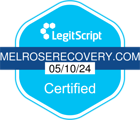Meth Withdrawal Symptoms In Los Angeles, CA

For those who use methamphetamine for an extended period of time, either legally or illicitly, the body grows accustomed to having the substance in its system. This can lead to withdrawal symptoms when there is no meth in the system. Understanding meth withdrawal and meth withdrawal symptoms is crucial not just for getting the proper treatment for meth addiction, but also for a better understanding of the effects of meth use and abuse on the body.
This resource helps learn more about meth withdrawals, why they happen, the timeline for meth withdrawal, some of the more common symptoms of meth withdrawal, and how you or a loved one can help with treatment for meth addiction.
What is the Timeline of Meth Withdrawal?
Within the first 24 to 48 hours after the last dose, an individual who is addicted to methamphetamines will experience a crash. This initial phase is often characterized by a sudden drop in energy and mood. The individual may experience extreme fatigue and sleep excessively as their body attempts to recover from the over-stimulation caused by meth use. Cravings for the drug can be very strong during this period.
Acute withdrawal begins around the third day and lasts up to 10 days. During this stage, the body continues to detoxify, and the brain starts adjusting to the absence of meth. Emotional and psychological symptoms can be pronounced, with depression and anxiety being particularly common. Physically, individuals might feel general malaise and discomfort.
Prolonged withdrawal can last from several weeks to months; often peaks around the second week and may persist for several months. This stage is marked by long-lasting emotional and psychological symptoms. While physical symptoms generally subside, the mental health effects, including depression and anhedonia, can linger. Cravings may diminish in intensity but can still occur, especially in response to triggers.
Your Transformation Start Here

Why Methamphetamine Withdrawl Occurs
This happens because meth increases the release of dopamine, also known as the feel-good drug in the brain. Since the meth is increasing the amount of dopamine in the brain, the brain reduces its natural production of dopamine, instead relying on the added dopamine output from the meth.
As a result, when someone either stops taking meth entirely, or the meth in the system starts to wear off before they take more, the brain rebels against the body due to low dopamine levels, leading to withdrawal symptoms.
Withdrawal symptoms can vary based on factors such as a person’s age, their overall health, the amount of meth they have been taking, and the length of their prolonged meth use.
Common Symptoms of Meth Withdrawl
Below is a timeline, complete with symptoms, that is common for meth withdrawal:
Acute Phase (Days 1-7)
- Fatigue and Excessive Sleepiness – Users often feel extremely tired and may sleep for extended periods.
- Increased Appetite – A sudden increase in hunger is common as the body tries to recover.
- Depression and Anxiety – Mood swings, feelings of hopelessness, and anxiety are typical as dopamine levels drop.
- Intense Cravings – The urge to use meth again can be powerful.
- Irritability and Agitation – Feelings of restlessness and irritation may be prominent.
- Cognitive Impairment – Difficulty concentrating, confusion, and memory problems can occur.
Over the next several days, these symptoms will often linger and in some cases even intensify. In addition, physical symptoms such as headaches and muscle aches may begin to emerge.
Subacute Phase (Weeks 2-4+)
During this period you can expect the following:
- Mood Swings – Emotional instability can continue.
- Cognitive Issues – Problems with memory and concentration may persist.
- Residual Cravings – Cravings can still be present but are typically less intense.
- Sleep Disturbances – Insomnia or restless sleep might continue.
After four weeks, many of the physical symptoms will begin to subside or be gone entirely. However, symptoms such as depression, anxiety, and cravings can continue to linger for months, even after treatment has been completed.
Managing Meth Withdrawl Symptoms
That being said, here are some things that you can do to be proactive when it comes to managing withdrawal symptoms associated with meth use:
- Stay Hydrated – Staying hydrated is crucial for overall health and can help alleviate some physical symptoms of withdrawal. While water is always good, consider sports drinks or other drinks with high amounts of electrolytes as well.
- Get Adequate Rest – Try and establish a sleep routine where you go to sleep and wake up at the same time every day. Make sure, when going to sleep, that you do so in an environment free of distractions.
- Nutrition and Exercise – Eat nutritious meals with plenty of fruits, vegetables, lean proteins, and whole grains to support your body’s recovery. Light to moderate physical activity is also important as it can improve mood, reduce anxiety, and help regulate sleep.
- Have Support Around You – Whether it’s opening up to family and friends or finding a support group of others who are going through something similar, it’s important to surround yourself with a support system.
- Manage Stress and Anxiety – Practices such as deep breathing, meditation, and yoga can help reduce stress and improve mental clarity.
Potential Risks and Complications of Methamphetamine Withdrawl
While in most cases, withdrawal symptoms are simply just uncomfortable and not life-threatening, in some cases, symptoms can get so bad that they require medical attention.
Below are some of the more extreme risks and complications that can come with methamphetamine withdrawal:
- Severe Depression
- Anxiety Disorders
- Nutritional Deficiencies
- Cardiovascular Issues
Should you experience medical complications of any kind, it is important to seek proper medical attention right away. Failing to do so can cause symptoms to worsen to the point where they can’t be treated or reversed.
Professional Treatment Options
For those looking to go through the withdrawal process with the help of professionals, there are treatment options available, ranging from intensive 24-hour care to lower levels of time commitment in outpatient care facilities.
The most common, and safest option, is detox. Detoxing can be done at a local medical facility, a dedicated detox center, or a substance use disorder treatment center that also offers detox services. By undergoing detox, you will have access to 24/7 medical care and monitoring by trained and licensed medical professionals who can provide various medications and over-the-counter supplements to help alleviate and even treat withdrawal symptoms.
At Melrose Recovery we provide an individualized approach to detoxification and closely monitor each patient to treat withdrawal symptoms as needed. After completing detox, we have other supportive programs to transition into and continue treatment for long-term recovery.
Inpatient, or residential treatment programs offer 24/7 care and medical interventions for individuals in recovery. Residential treatment programs require individuals to stay in the treatment facility while receiving addiction treatment services. Typically a residential program lasts for 30, 60, or 90 days. The duration of stay depends largely on the individual needs of a client.
Treatment involves a number of different therapy and counseling sessions including:
- Individual Therapy
- Group Therapy
- Cognitive-behavioral therapy (CBT)
- Dialectical Behavioral Therapy (DBT)
- Contingency Management
- Experiential Therapy
Another option for treatment of meth addiction includes outpatient treatment. There are varying levels of outpatient care including, intensive outpatient programs, partial hospitalization programs, and traditional outpatient treatment. In an outpatient program, patients travel to the treatment facility each day and attend therapy sessions and receive medication if necessary. Each day, treatment lasts from 9 to 3 hours, then patients return home.
Support groups, such as group therapy, are a crucial part of the overall treatment and recovery process. Support groups provide the support system needed to handle any temptations or cravings you may experience in a positive and healthy manner.
Recovery from addiction of any kind is a lifelong process that does not end after treatment has been completed. That’s why aftercare programs and ongoing support are just as crucial to the overall recovery process as treatment is.
Continuing to attend support group meetings and have regular therapy sessions can not only help build on the progress that has already been made, but it can also help address any new issues that may arise as you learn to properly navigate your new, sober life.

Get Help With Your Meth Withdrawl Symptoms at Melrose Recovery
At Melrose Recovery, we understand the importance of withdrawing under the care and supervision of professionals. That’s why, in addition to our treatment programs, we also offer detox services for a variety of substances of abuse, including meth. Those coming to our facility to detox can remain with us for the full duration of residential treatment as well.
In addition to detox and inpatient treatment, we also offer a variety of support services, including aftercare to make sure that you stay on the right track in your recovery journey even after you have left our facility and returned back to your daily life.
If you or a loved one is struggling with meth addiction or are experiencing adverse effects of meth withdrawal, contact us today.
Taking the First Step Toward Addiction Recovery
At Melrose Recovery, our addiction specialists strive for the highest quality of care and are here to change lives for the better









